- Submissions

Full Text
Environmental Analysis & Ecology Studies
The Phenomenon of Sand Encroachment in the Region of Ain Sefra in the Saharan Atlas (South- Western of Algeria) Conditions and Factors
Bouarfa Said1,2*, Bellal Sid Ahmed1 and Belmahi Mohammed Nadir1
1 University of Oran, Algeria
2 Center of Scientific and Technical Research on Arid Regions (CRSTRA), Campus Universitaire, Algeria
*Corresponding author:Bouarfa Said, Center of Scientific and Technical Research on Arid Regions (CRSTRA), Campus Universitaire BP n° 1682 RP 07000, Biskra, Algeria
Submission: February 20, 2018;Published: August 10, 2018

ISSN 2578-0336 Volume3 Issue4
Abstract
Nearly 20 million hectares are threatened by desertification in Algeria, where the sand is a real problem, especially in arid areas. Therefore, it was useful to analyze various parameters of Sand encroachment separately based on a confrontation between them in order to understand the mechanism of siltation in the study area. After citing the factors and conditions of the sand, we have processed the wind data and rainfall data coupled with the thermometer. The morphology, geological outcrops, the water system, and behavior of humans on the environment are also key factors that affect the sand.
The sand was mainly negative impacts of greater or lesser importance depending on the environment and its components. The first impact that conditions other is the loss of biodiversity, among other impacts on ecosystems, we cite: the desertization, desertification, air pollution by sandstorms during certain times of the year, draining of water point, lowering of the groundwater level, food insecurity due to loss of productivity of land and pasture generating the impoverishment of local populations and their economic and social instability [1].
keywordsDegradation; Desertification; Sanding; Economic; Erosion; Wind; Environment; Wind; Sand; Social
Introduction
Desertification is the transformation of a landscape or nondesert environment into an environment with characteristics of a desert landscape (dunes, Reg, degradation, or even lack of vegetation cover [2]. It is the transformation of fertile lands into deserts or semi-arid zones into arid zones because of various factors including climatic variations and human activities. This phenomenon, which affects all continents, is gaining about 10 million hectares a year, or nearly a quarter of the total land area of the Earth’s surface. Drought, a climatic phenomenon, essentially causes a severe water shortage that temporarily limits the possibilities of agricultural production.
In Algeria: 200 million ha occupied by the Sahara. 23 million hectares affected by desertification (steppe and semi-arid zones) 12 million has affected by water erosion (WMO).
This phenomenon, likened to a major risk, is taking on alarming proportions in Africa and particularly in the Maghreb countries and especially in Algeria, and is threatening the survival of people living in arid and semi-arid zones and jeopardizing food security. Therefore, the steppe in its territorial dimension is to be placed at the forefront of the concerns that arise for the future, not only for the sake of developing and developing an area that represents both a space and a depth strategic in terms of spatial planning, but also and above all to combat the current of degradation that has reached its potential production and which has engaged for several decades, the pastoral economy in a process of decline, extending to the fertile areas of the tell.
In Algeria, the equilibrium of the steppe ecosystem has for a long time been ensured by a harmony between man and the space in which he lives. This balance is ensured by ancestral human practices that allow the sustainability and regeneration of natural resources. However, this territory, which was the space of nomadism and large transhumance, has undergone profound changes. The various crises that ancestral pastoral society has endured have led to the emergence of new practices, foreign to the way of life of the steppe populations. Because of these changes, the steppe territory [1], Laboratory of Agro Biotechnology and Nutrition in Zones) is becoming more and more serious and felt at all levels. Semi-arid University of Tiaret, Year 2008.
Indeed, desertification at this level extends dramatically. The arid zones characterized by the fragility of their ecosystem, are the first areas subject to the phenomenon of degradation and Sand encroachment. The latter has been very complex and is intrinsically linked to extra zonal factors both in terms of climate and in terms of the regional processes of wind transport of sand between source zones and deposit zones.
The understanding of the phenomenon was made possible thanks to the combined effect of édapho-climatic actions, geological and geomorphological factors. It is clear, therefore, that the explanation is not limited to only local factors over similar regions.
Materials and Methods
Study area
The study area is part of the south-west of the high plains Oran, part of the Ksour Mountains and forming the western part of the Algerian atlas chain. It constitutes the extension towards the east of the high atlas in Morocco. The region of Ain Sefra belongs administratively to the willaya of Naâma, limited by the willaya of Tlemcen and Sidi bel Abbes in the North, the willaya of el Bayadh in the East and the South by the willaya of Béchar (Figure 1).
Figure 1:Map of the administrative situation of the region of Ain Sefra.
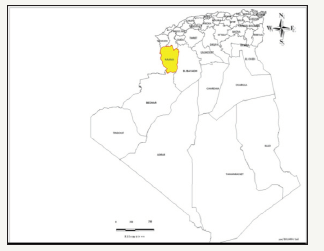
The morphology of the area is the result of the arrangement between two agents: altitude and slope, which by its binding effects, is one of the salient factors for our study. In this vast territory of the willaya of Naâma, the relief intervenes in two major constraints: The phenomenon of Sand encroachment and the risk related to the floods. The plain is slightly inclined towards the north where the altitudes are between 1100m in the north and a little more 1200m in the south. On the altimetry plan, like its natural zones, the willaya of Naâma is compartmentalized in three stages: the zone of high plains, which corresponds to the northern part of the atlas chain.
The high plains area corresponds to large, relatively flat and monotonous areas, interspersed with depressions (Chott Gharbi in its central part, Naâma depression in the south, day as) This area is situated at an altitude of between 975m (Chott El Gharbi depression) and 1,226m (Jebel Sidi El Abed). The Ksour Mountains This is the most important zone, distinguished by its very high altitude, which often exceeds 1,500m. It is home to two mountainous entities aligned from west to east. Slope classes are identified with the three natural areas of the region: The north and south zones, with relatively flat topography, fall into the slope class of less than 3% (Figure 2).
Figure 2:Map of the altitudes of the area.

Geology, lithology and soil: The western Saharan Atlas is limited by the high plains of Oran by the accident North-Atlasique and the Saharan platform by the south Atlas accident (Figure 3), while continues to the West by the High Atlas Moroccan and the rigid domains of Tamelt and Tigri and to the East by the central Saharan Atlas (Djebel Amour). It continues eastward by the Mount oued Nails. From a tectonic point of view, the Western Saharan Atlas or the Ksour Mountains is made up of a series of loose folds, flanked and spanned, separated by sometimes-perched synclines overlooking vast plains that facilitate North-South and East communications. Where is from a stratigraphic point of view, the Ksour Mountains consist essentially of Mesozoic formations with a total thickness of about 6000m.
Figure 3:Geological map of the area.

The hydrographic network and the flows of the region are conditioned by the relief structure of the latter. The High Steppes Plains area: This zone, which is part of the geographical area of the large Chott Chergui watershed, has a poorly developed hydrographic network; It is characterized by a relatively flat topography and strewn with depressions (Chott Gharbi, depression of Naâma), which is at the origin of the endorheic character of these wadis. The latter are of diffuse and intermittent flow; they originate in general on the reliefs of the Saharan Atlas and finish their course in the plain at the level of the depressions (Figure 4).
Figure 4:Watershed of oued Ain sefra-El Breidj.

Hydrogeology
The Ksour Mountains, whose catchment basins are particularly extensive, contain aquifer systems with complex lithostratigraphiques structures and formations [3]. Most of these aquifers are multi layers, with free water, intercalated by semipermeable formations. The groundwater resources of the region come from several aquifer systems whose formation is favored in the geological context. According to the hydrogeological study on the region carried out by Mansour H [3], it is considered that the potential in groundwater falls into two domains (Figure 5).
The Factors and Conditions of the Sand Encroachment of the Study Area
Climatic conditions
Generally, the regions affected by Sand encroachment correspond to the arid and Saharan bioclimatic stages, whose main ecological characteristics such as climate and geomorphology. Metrological indices such as Precipitation, Temperatures, Evapotranspiration and Winds are indicators of the threat of Sand encroachment to the region.
Irregularity of precipitation
Aridity corresponds to the insufficiency and irregularity of rainfall (Table 1) and the increase of the thermal amplitude, the main consequence of which is drought and degradation of the vegetation cover; it predisposes the region to Sand encroachment if it is associated with the wind.
Table 1:The rarity of rainy days, the maximum number of rainy days is 83 with a precipitation of 439mm (November 2008), the number of rainy days is 13.67% of the sum of the days of the period 1999-2006.
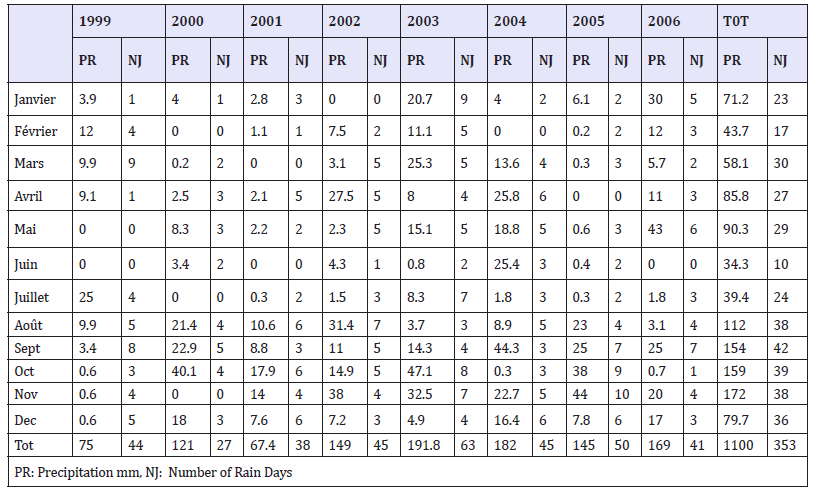
At Ain sefra, the average maximum temperature is 40.4 °C in July 2005, and the minimum average is -2 °C in February 2005, the averages are between 3 °C and 33 °C. The annual temperature increase is 36.96 °C (Table 1&2); (Figure 6). Note that the annual average for the period from 1999 to 2016 is 26.98 °C. The minimum average is 2 °C in January and the maximum average is 38.96 °C in July.
Table 2:Mean annual temperatures (1999-2016) Ain Sefra.
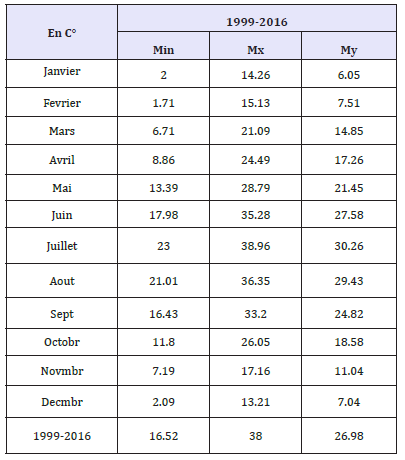
Figure 5:Hydrogeological map of Ain sefra (H Mansour 2007).
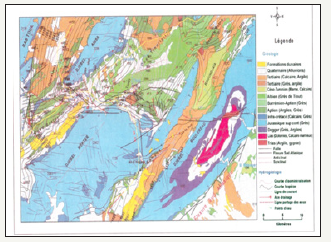
Wind
Wind is a moving mass of air in a horizontal component that flows from the high to the low pressures. From a speed between 4 and 6m/s the wind lifts the soil particles and causes their migration. At this threshold, it is said that the wind is effective (Figure 7).
Dynamic wind regime at AIN SEFRA (1999-2016): To study the wind regimes, we need wind speed records in 16 directions for a period of 8 readings per day
Figure 6:Average monthly rainfall and number of rainy days at AIN SEFRA from 1999 to 2016.

Figure 7:Dynamic wind and calm rates for the period 1999 to 2006 at Ain Sefra.

The Potential Mobility of Sables an Ain Safra
We show here the relation between the force of the wind and the displacement of the sand. The recorded wind observations for the Ain Sefra meteorological station are for long periods (1999- 2016); they are represented as a simple diagram with vectors representing the movement of the sand using a software program. Chopy B (1985) named “sand”. For the eight years of observation and for the whole of the study area we have quantified the potential energy coefficients for the region of Ain Sefra, the displacement and the potential drift of the amount of sand that the wind is competent to transport are made towards the Northeast direction for the duration between 1999 and 2016, we have the following results
Transport Capacity (Ct): 1482 25 vector units (UV) is q’= 102 57m³/m/year and q’ ‘= 171 29 T/m/year. The Resulting Module (MR): 190.09UV
Resulting Direction (DR): 237 °SW
The Coefficient of Migration (MR/CT): 0.13
At Ain Sefra, the transport capacity is large and classifies the region as high-energy environment according to the classification established by Fryberger [4]. The sand migration coefficient is low (Figure 8).
Figure 8:Roses of potential displacement of sand in Ain Sefra for the period 1999-2016 for a Speed>= 4m/s.
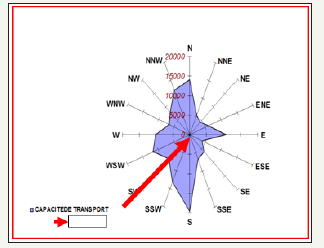
Geologic outcrops and lithology
Sand is any particle or fragment of rock that is likely to be transported or moved by the wind. This mobilization generally occurs from a speed of between 4 and 6m/s. Depending on their granulometric, the sand grains are fine or coarse. The geological nature of the parent rock gives the grains different densities and hues. The round grain shape is due to the friction they experienced along their migration path. FAO.
Each dune is composed of sand from one or more origins designated according to their distance by own names. There are three main origins of sand forming the dunes, namely:
A. Aboriginal Origin: Sand is said to be of Aboriginal origin if it originates from sources within the region where Sand encroachment is occurring [5].
B. Inside this same origin were said of local origin any Sand encroachment caused by sand from a place, which includes the object, silted.
C. Allochthones origin: A sand is said to be of allochthones origin if it comes from sources located outside the region where Sand encroachment is observed.
D. Self-allochthones origin: A Sand encroachment is said of this origin if the sand, which constitutes it, comes from the two aforementioned origins. It is also said that this Sand encroachment is of mixed origin.
In addition, a source of sand is any location that produces or contains quantities of sand capable of forming or feeding Sand encroachment. Depending on their importance, these sources are either transitional (the case of sanding by dune on the move) or supply, initially ensuring the formation and feeding of the dunes.
Mother sources of sand
The rocks: The granular decomposition and the friability of certain rocks under the physicochemical effects of the climate give rise to the sandy particles. The mountains, the regs and hammadas are true inexhaustible sources of material of sand. Sand Proving Sources: These are natural environments whose structures contain sand in the shaped state. Among these many sources, the main ones are: Matrix terraces made up of fine elements. Alluvial and colluvium deposits-Ergs and other dune accumulations (Figure 9).
Figure 9:Sources providing sand.
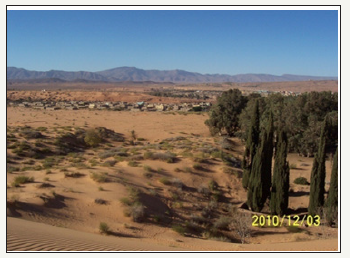
The results obtained by MEDIENE.H show that the alluvial deposits of Oued Ain Sefra are generally transported by suspension and rolling with grain sizes varying between 0.125 and 0.4 mm. These alluviums are mostly composed of sands.
The geomorphological factor
The landscape is made up of barren and heavily eroded mountainous formations interspersed with vast expanses of regs and fluvial plains.
The morphological intervention is important when it directs the direction of the prevailing wind and distributes it in two main corridors, one between djebel Mourghad and Aissa and the other between djebel Aissa and Mekther: when the winds blow between the massifs mountainous, they change directions suddenly because of the violent action of the wind on djebel (the echo effect) which causes a decrease in its speed, so the morphology offers places where the wind imposes action especially at the foot of the djebel.
The geomorphological factor
The landscape is made up of barren and heavily eroded mountainous formations interspersed with vast expanses of regs and fluvial plains.
the morphological intervention is important when it directs the direction of the prevailing wind and distributes it in two main corridors, one between djebel Mourghad and Aissa and the other between djebel Aissa and Mekther: when the winds blow between the massifs mountainous, they change directions suddenly because of the violent action of the wind on djebel (the echo effect) which causes a decrease in its speed, so the morphology offers places where the wind imposes action especially at the foot of the djebel.
Plant formation and hydrographic network
These difficult conditions described above do not allow the development of a rich and varied vegetation. Most of this vegetation is concentrated along streams and channels. Outside these environments, steppe-type discontinuous vegetation does not provide soil protection against wind erosion [6].
The plant carpet found in the Ksour Mountains is characteristic of semi-desert regions. It is a transitional zone between Saharan vegetation and steppe vegetation, consisting mainly of sagebrush and alfa. In the region of Ain Sefra, it is replaced by the Remet (Haloylon). At high altitude it happens that we meet trees such as Aleppo pines, isolated or groups in bunches. The hydrographic network makes it possible to distinguish at the level of the Saharan Atlas, two zones: One in the North with a diffuse flow, very little develops, feeding the sebkhas and the dayats, the other to the south, with a rather dense general flow, directed towards the great western Erg and crossing entirely the Saharan atlas.
“This age of wind power has allowed for the digging of large, wind-driven depressions of hydro-wind-generated origin by alteration of the rock by water, and then wind-export of fragmented material. Since the Plio-Pléistocèn [7,8].
Man’s behavior
For a long time nature has suffered from human nuisance and through its needs of raw materials and the misuse of natural resources (maximum and irrational exploitation) on which a human activity is exercised throughout the world. Pastoralism, which proves to be more and more intense, causing the degradation of the plant, cover of the supporting soils [9].
The needs of the local population for heating and grazing energy as well as the extension of shifting cultivation are the main human activities implicated in the imbalance of the ecosystems of this environment and consequently the triggering of the phenomenon in Sand encroachment up.
The area of Ain Sefra has suffered from excessive exploitation of its natural wealth (alfa, forests, etc.). Nevertheless, after the colonial period until now the excessive exploitation, the anarchic plowing, the overgrazing and the high number of wells lower the piezometric level decrease the soil moisture. Thus livestock farming remains the main economic activity of the region (Table 3), with a predominance of sheep, which, despite everything, has undergone a drastic decrease since 1990, while the other areas (cattle, goats and camels) were sharply increasing until 1996, the date of the total regression of all livestock. In fact, in the 1990s, along with this regression of sheep, the number of cattle increased significantly; it has increased considerably since 1991. This increase is rapid, from 8,940 head in 1990 to 21,300 in 1991 [10-14].
Table 3:Distribution of pastoralists by communes 2016. NAAMA willaya agricultural services directorate.

Conclusion
The phenomenon of Sand encroachment is very complex and is intrinsically linked to extra zonal factors both in terms of climate and in terms of regional processes for the wind transport of sand between source and deposition zones. Understanding the phenomenon requires more years of research [15].
Thus, land erosion and Sand encroachment make the soil unproductive and engulf entire villages and communication routes. It causes the depletion of natural resources (fauna, flora and other aquatic resources). It also leads to famine [16]: lack of sufficient agricultural resources families is obliged to reduce their food intake quantitatively. In search of grazing, pastoralists no longer respect the transhumance corridors, which creates antagonisms most often tragic (conflict breeders-farmers).
On the economic level, there is a drop in agricultural production, a shift of pastoralists to areas that are not often conducive to the development of livestock. At the level of the rural population is endemic poverty that rages. The fight against Sand encroachment is often carried out for emergencies. They mainly concern the dune fronts and remain punctual and very limited in the absence of a global approach integrating the entire ecosystem.
References
- Adda A, Maatoug M, Sahnoune M (2006) A Laboratory of Agro Biotechnology and Nutrition in Semi-Arid Zones University of Tiaret. 1st International Seminar on Desertification and Desertification from 12 to 14 June 2006.
- Aidoud A (1989) Contribution to the study of the grazed steppe ecosystem of the Algero-Oran highlands (Algeria): Operation, assessment of plant resources. Doctoral thesis, univ sci, tech, Houari Boumediene, Algiers, Algeria.
- Mansour H, Issaadi A, Stamboul M, Zerouial I (2008) Bulletin du Service Géologique National 19(1): 73-82.
- Fryberger SG, Dean G (1979) Dune forms and wind regime. A study of global sand seas 1052: 137-169
- Belmahi MN (2015) Sands and development in arid and semi-arid environments on the northwestern margins of the Algerian Saharan Atlas. Faculty of Earth Sciences, Geography and Spatial Planning, p.276.
- Bouarfa S (2012) The phenomenon of silting in the southwest of the region of Ain Sefra: Conditions, factors and impacts on the environment. Ahmed Ben Bella University of Oran1 Es Senia, Algeria.
- Callot Y (1987) Géomorphologie et paléoenvironnements de l’Atlas saharien au grand erg occidental. These de doctorat, Université de Paris, France, p. 6.
- Callot Y, Oulehri T (1996) Aeolian sand geodynamics in the north-western Sahara: Relations between aerology and geomorphology. Geodinamica Acta 9: 1-12.
- Couderc (1978) Les haut plaine stepique sud oranie -these 3em cycle université plaul valery.
- Callot Y, Bisson J (1990) Les hommes et la sécheresse autour du grand Erg occidental (nord-ouest du Sahara algérien). Secheresse 1(2): 124- 133.
- Callot Y (1997) Géomorphologie et paléo environnement de l’Atlas saharien au grand erg occidental. Mémscterre univ pet M Curie, Paris, France, p. 412.
- Callot Y, Bisson J (1994) Milieu physique et aménagement au Sahara ou la difficulté du développement au désert. Unvi Froncois Rabelais URBAMA (URA 365.CNRS).
- Marius C (1995) Le problème évolutif du phénomène d’ensablement et ses impacts négatifs sur les mangroves du Sénégal.
- Pétrov MP (1957) La phyto-amélioration des déserts de sa bles en URSS annales de géographie.
- Bagnold RA (1951) Forme des dunnes de sable et regime des vents, p. 24.
- Rognon P (1996) La sécheresse et l’aridité et leur impact sur la désertification.
© 2018 Bouarfa Said. This is an open access article distributed under the terms of the Creative Commons Attribution License , which permits unrestricted use, distribution, and build upon your work non-commercially.
 a Creative Commons Attribution 4.0 International License. Based on a work at www.crimsonpublishers.com.
Best viewed in
a Creative Commons Attribution 4.0 International License. Based on a work at www.crimsonpublishers.com.
Best viewed in 







.jpg)






























 Editorial Board Registrations
Editorial Board Registrations Submit your Article
Submit your Article Refer a Friend
Refer a Friend Advertise With Us
Advertise With Us
.jpg)






.jpg)













.bmp)
.jpg)
.png)
.jpg)














.png)

.png)



.png)






